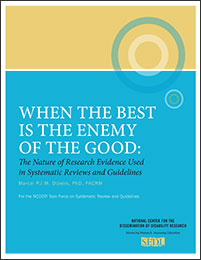When the Best Is the Enemy of the Good: The Nature of Research Evidence Used in Systematic Reviews and Guidelines

Author: Marcel P. J. M. Dijkers
| Price: Available free online |
Available online: Full text, PDF
![]()
The Task Force on Systematic Review and Guidelines developed "When the Best is the Enemy of the Good." This task force paper explores critical issues related to the "gold standard" for research designs, the emergence of systematic reviews, and implications for evidence-based rehabilitation and clinical practice.
Evidence-based practice, according to authoritative statements by the founders of this approach to health care, involves using the "best available" evidence in addition to clinical expertise and patient preferences to make decisions on the care of patients. However, many systematic reviewers interpret "best available" as "best possible" and exclude from their reviews any evidence produced by research of a grade less than the highest possible (e.g., the randomized clinical trial [RCT] for interventions), even if that means making no recommendations at all. Voltaire's comment that "the best is the enemy of the good" is applicable here. Rehabilitation would be disadvantaged especially, as it can boast few RCTs, because of its nature. The myopic focus on the "strongest" research designs may also steer researchers away from asking, "What is the best design to answer this research question?" Lastly, rehabilitation and other clinicians need to know not just which interventions are effective, but also how these interventions need to be delivered; information relevant to this latter aspect of knowledge translation is typically produced using "weak" research designs.
Suggested Citation:
